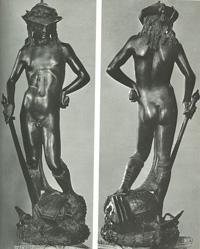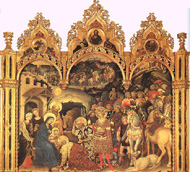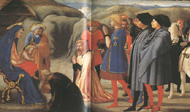SLIDE LIST 4
SLIDE LIST 4

|

|
||
| View of Florence from San Miniato | Duomo (Cathedral), begun 1296, Dome constructed by Filippo Brunelleschi between 1417-36. Campanile or Bell Tower was designed by Giotto, 1334 | ||
|
|

|
||
| Orsanmichele: was originally an open-arcaded market. It served as the central grain exchange and as a oratory or shrine dedicated by the guilds. Each guild was assigned a niche on the exterior of the building. | Palazzo Vecchio, 1299-1310. As the city hall the Palazzo Vecchio and the Piazza in front of it were the primary civic center of Florence and a symbol of its Republican form of government. | ||
|
|
|
||
| Lorenzo Ghiberti (1381?-1455), St. John the Baptist, c. 1412-16, made for the cloth producers guild's niche on Orsanmichele. | Donatello (c. 1386-1466), St. Mark, 1411-1413, commissioned by the linen drapers and peddlers guild for their niche on Orsanmichele. | ||
|
|
|
||
| Donatello, St. George, c. 1415-17, made for armorers and sword makers guild. Orsanmichele. | Details of St. George | ||
|
|
|
||
| Donatello, David, after 1428, documented in 1469 as being in the courtyard of the Medici Palace.(For other views) | Donatello, Mary Magadalen, c. 1455. | ||
|
|


|
||
| Detail of head of Mary Magdalen. | Detail of head of David. | ||
Leonardo Bruni, excerpt
from Isagogue of Moral Philosophy:
Man is naturally constituted to perform a certain activity proper to himself
alone. But this activity cannot be the simple act of living, since that is shared
with the plants; nor is it sensation, since even the brute animals possess sensation.
It is, rather, life and action according to reason. Whoever uses his reason
with ability and excellence fulfills proper work for which he was naturally
constituted. To live and act well: that is the highest good of man we are seeking....
Virtue alone they [the ancients] considered sufficient for happiness.... The
wise man and the brave man (in the true sense of the word), armed with a great
and unconquerable spirit, relies on himself alone and is never frightened by
the mischances of humankind or the threats of fortune....
The proper activity of man can therefore only consist in rational activity....
A man can, in fact, have knowledge of an almost infinite number of things, provided
he is willing to spend time studying them. He has, surely, a mind that partakes
of the Divine Mind, and he is, as it were, a mortal god.
Humanism: is a term coined
in the 19c, invented to describe the program of study, and its conditioning
of thought and expression, that was known from the 15c as the province of the
umanista, the teacher of the studia humanitatis or arts curriculum
in schools. The body of study focused on the study of ancient texts, primarily
Latin but also Greek and Hebrew, dealing with grammar, rhetoric, history, poetry,
and moral philosophy. Such a program was secular, concerned with man [sic],
his nature and his gifts. Renaissance humanism should not be confused with the
modern notion of humanitarianism.
There were various types of humanism that developed in the Renaissance including:
"civic humanism" focused on the role of the individual in civic life
with special emphasis on rational action; "artistic humanism" placed
emphasis on the emulation of forms derived from the classical tradition of Greek
and Roman art; "poetic humanism" was the conscious study of and imitation
of the form and content of Greek and Latin literature; "Christian humanism"
was the application of study of ancient languages (Latin, Greek, and Hebrew)
to a critical understanding and translation of the Bible.
"Virtù": The architect and theorist Leon Battista Alberti used
the Italian word "virtù" for "those excelling gifts which
God gave to the to the soul of man, greatest and preeminent above all other
earthly animals." A man of virtù in Renaissance in Renaissance
Italian, coming from the Latin virtus and having its root in the Latin
word vir or man, was a man [sic] with active intellectual power to command
any situation, to do as he intended, like an architect producing a building
according to plan; by contrast with someone at the mercy of fortuna,
of chance or luck, of the accidents of fortuitous circumstance, unforeseen and
hence out of control. The man of virtù aimed, the virtuoso,
aims at reasoned and examined control alike of his own thoughts, intentions,
and actions and also of his surroundings.
Contrapposto- literally: placed opposite. The disposition of the human figure in which one part is turned in a direction opposite that of the other (usually hips and legs one way, shoulders and chest another)- thus a counterpositioning of the body about its central axis. Sometimes called "weight-shift" since the weight of the body tends to be thrown to one foot, creating tension on one side and relaxation of the other. The weight-bearing leg, or engaged leg, is distinguished from the raised leg, or free leg, and the resulting shift in the axes of hips and shoulders is observed. Contrapposto was developed by Greek sculptors of the fifth century B.C. as a means of increasing the animation of the figure. Contrapposto was not used during the Middle Ages, but was revived by Donatello and other Renaissance artists. Masaccio has used contrapposto in his Tribute Money.
Fresco: a painting on fresh, wet plaster with pigments suspended in water. The
fresco technique is usually used of decorating walls or ceilings. The plaster
absorbs the colors, and, when it dries, makes a very durable painting. Since
plaster dries rather quickly, only a small section, large enough to be painted
at one time, is laid on with wet plaster. The final layer was usually applied
over an outline drawing (sinopia) of the composition, which had been previously
been made on a layer of pough plaster.
Tempera: Pigments mixed, or "tempered", with any of a number of water
soluble media-including egg, glue, and casein (milk).
Linear perspective- One of the major contributions of early fifteenth century art was the 'discovery' of linear perspective. It is generally agreed that the Florentine architect Filippo Brunelleschi was the central figure in the 'discovery', but other artists like Masaccio, Donatello, and Ghiberti soon adopted it. It presented artists with a means of rationalizing the relationship between objects within a picture, and its systematic use also defines a relationship between the viewer and the represented image. Linear perspective is based on the observation that all parallel lines which recede into the distance at the same angle (orthogonals) appear to converge toward a single point (vanishing point), and that this point appears along a plane (horizon line) which corresponds with the point of view of the observer. In the Tribute Money, Masaccio has used linear perspective. Notice if you continue the lines of the building on the right that they intersect at a point located in the head of Christ. By using this system Masaccio has presented a convincing illusion of depth and created a strong compositional focus. In the Trinity, Masaccio has used linear perspective again, but notice how he has placed the vanishing point beneath the base of the Cross which corresponds to our actual vantage point in viewing the work.
A good discussion of the origins of linear perspective and its place in the development of early modern scientific thought is found at the site: The Art of Renaissance Science: Galileo and Perspective.
Contemporary critical theory
has emphasized the cultural implications of perspective
on the Western world view.
Foreshortening- a method of representing objects or parts of objects as if they were seen at an angle and receding into space instead of being seen in a strictly frontal view. The objects appear contracted. For example, a foreshortened circle will be an oval. Notice how Masaccio has used foreshortening in the positioning of the disciples around Christ in the Tribute Money. We understand Him as being the center of a circle. Foreshortening was developed by 14th and 15th century Italian painters, and represented an important device in creating the illusion of depth.
Atmospheric perspective ( or aerial perspective)- the representation of spatial effects which are caused by the interposition of the atmosphere between the viewer and distant objects; these effects include blurring of outlines, loss of detail, alteration of hue toward blue, and diminution of color saturation, and value contrast. Atmospheric perspective became another important tool for Renaissance artists to create the illustion of depth.
Linear perspective which employs mathematics to rationalize space is an important instance of the close relationship between art and science in the Renaissance. The site The Art of Renaissance Science provides a useful overview of this topic.
The Web Gallery of Art presents a tour of the Brancacci Chapel. Carol Gerten-Jackson presents a good collection of the work of Masaccio. The Vatican site, Christus Rex, also presents an excellent site on the Brancacci Chapel.
A good overview of the work of Donatello is found at the Web Gallery of Art.
See also see the web-site made by the National Gallery of Art to accompany the 2005 exhibition Monumental Sculpture from Renaissance Florence.
|

|

|
| Donatello, David, after 1428. | Donatello, Mary Magdalen, c. 1455 |
This comparison illustrates the range of "virtuosity" of the work of Donatello. Considering the differences in media and the dramatic constrasts in expression, it is hard to imagine that these are works by the same artist. Articulate the differences of these works. Discuss these in relationship to the different social functions and patronage of the two works.
|

|


|
| Gentile da Fabriano, Adoration of the Magi, from the Strozzi Altarpiece, finished 1423. | Masaccio, Adoration of the Magi, from the Pisa Altarpiece, 1426. |
Compare and contrast the styles of these works. Define aspects found in the two works which exemplify Renaissance artists' concern with the observation of the world. Clearly bring out the distinctions between the styles of these works. Relate these differences to the different social ideologies presented by these works. An important distinction should be seen in the artists' representations of space and light.